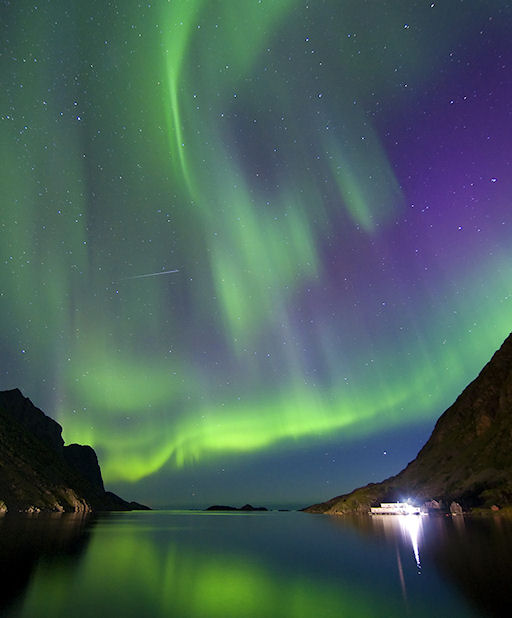AURORA ALERTS: Did you miss the Northern Lights? Next time get a wake-up call from Space Weather PHONE | | |
GROUND CURRENTS IN NORWAY: Rob Stammes operates a geomagnetic observatory in Lofoten, Norway, and he is measuring strong ground currents on Sept. 8th: "Magnetic activity began around 15.00 UT," says Stammes. "The ground currents are much stronger than last night when the auroras were bright. If this continues, we might see an even better display this evening."
PURPLE AURORAS: Auroras are dancing around the Arctic Circle today and some of them are purple. Here is how the sky looked this morning, Sept. 8th, over Bø, Norway:

"It's not often I get to see purple auroras," says photographer Øystein Lunde Ingvaldsen. "This was truly a fantastic sight!"
Auroras get their colors from specific atoms and molecules in Earth's atmosphere. Green comes from oxygen molecules excited by geomagnetic activity. Purple, on the other hand, is usually a mixture of red and blue emissions from molecular nitrogen. O2 and N2 were both revved up in Norway last night!
More purple is possible tonight as a solar wind stream continues to buffet Earth's magnetic field. High-latitude sky watchers should remain alert for auroras.
NEW: Sept. 2010 Northern Lights Gallery
[previous Septembers: 2009, 2008, 2007, 2006, 2005, 2004, 2002, 2001, 2000]
A MAGNETIC FILAMENT ERUPTS: Yesterday, Sept. 7th, a long, dark magnetic filament on the sun became unstable and--snap!--it erupted. NASA's Solar Dynamics Observatory recorded the action:

One of the amazing things about SDO is that it acts like a thermometer. Using special extreme ultraviolet filters, the observatory can distinguish cool (~80,000 K) vs. hot (1,000,000 K) plasma, revealing physics that previous solar observatories could not. Look at the difference between the cool movie and the hot movie. Researchers may be able to use this information to figure out what triggered the eruption and how it unfolded.
Curiously, the eruption was mostly "empty." It did not propel a substantial cloud toward Earth. There is, however, a hint of a faint coronal mass ejection (CME) in SOHO coronagraph data. The diaphanous CME could bump into Earth's magnetic field on or about Sept. 10th, boosting any ongoing geomagnetic activity.
Potentially Hazardous Asteroids (
PHAs) are space rocks larger than approximately 100m that can come closer to Earth than 0.05 AU. None of the known PHAs is on a collision course with our planet, although astronomers are finding
new ones all the time.
On September 8, 2010 there were 1144 potentially hazardous asteroids.
Notes: LD means "Lunar Distance." 1 LD = 384,401 km, the distance between Earth and the Moon. 1 LD also equals 0.00256 AU. MAG is the visual magnitude of the asteroid on the date of closest approach. | | The official U.S. government space weather bureau |
| | The first place to look for information about sundogs, pillars, rainbows and related phenomena. |
| | Researchers call it a "Hubble for the sun." SDO is the most advanced solar observatory ever. |
| | 3D views of the sun from NASA's Solar and Terrestrial Relations Observatory |
| | Realtime and archival images of the Sun from SOHO. |
| | from the NOAA Space Environment Center |
| | from the National Solar Data Analysis Center |

